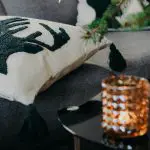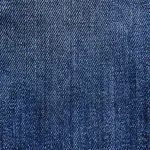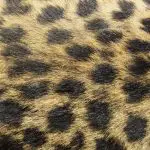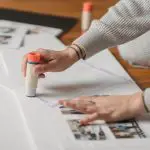Are you looking to add a touch of elegance to your fabric creations?
In this article, we’ll show you how to attach silk flowers to fabric effortlessly.
Whether you’re creating a beautiful dress, a stunning headpiece, or a decorative pillow, this guide will provide you with the necessary techniques to achieve a flawless result.
From choosing the right silk flowers to mastering sewing techniques and using adhesive, we’ve got you covered.
Get ready to elevate your fabric projects with the beauty of silk flowers!
Table of Contents
Choosing the Right Silk Flowers
When choosing the right silk flowers, make sure they match the color scheme of your fabric. This is essential for creating a harmonious and visually appealing arrangement. Silk flowers come in a wide variety of colors, so take the time to compare them to your fabric before making a decision. Consider the overall theme and mood you want to convey with your silk flower arrangements and select flowers that complement it.
In addition to color, consider the size and shape of the silk flowers. If you are creating a large centerpiece or statement piece, opt for larger flowers that will make a bold impact. For smaller arrangements or delicate fabrics, choose smaller flowers that won’t overpower the fabric.
When it comes to silk flower care, it’s important to choose high-quality silk flowers that are made to last. Look for flowers that are made from durable materials and have a realistic appearance. Avoid flowers that are easily damaged or have a cheap, plastic-like look.
Preparing the Fabric for Attachment
Before you start, make sure the fabric is clean and free of any wrinkles. Ironing the fabric before attaching silk flowers is an essential step in ensuring a smooth and professional finish.
To begin, set your iron to the appropriate temperature for the fabric type. If you’re unsure, consult the fabric care label. Lay the fabric flat on the ironing board, making sure it is completely smooth. Gently glide the iron over the fabric, applying light pressure. Start from one edge and work your way across, making sure to cover the entire surface.
Be cautious not to linger in one spot for too long, as this can cause scorching or damage to delicate fabrics. Pay extra attention to any stubborn wrinkles, using the steam function if necessary.
Once the fabric is wrinkle-free, allow it to cool completely before attaching the silk flowers. This will ensure that the fabric retains its smoothness and the flowers adhere properly.
Following these simple fabric preparation techniques will result in a flawless and professional-looking finished product.
Sewing Techniques for Attaching Silk Flowers
To sew the silk flowers onto your project, start by selecting a thread that matches the color of the fabric. This will ensure that the thread blends seamlessly with the fabric, giving your project a professional finish.
When attaching silk flowers, there are a few embroidery techniques you can use to secure them firmly. One popular technique is the satin stitch, where you stitch closely spaced straight stitches over the base of the flower. This not only secures the flower in place but also adds a beautiful textured effect.
Another technique is the whip stitch, where you stitch around the edges of the flower, creating a border that holds it securely. For a more intricate look, you can use a combination of embroidery stitches like the French knot or the seed stitch to attach the silk flowers.
Sewing patterns for adding silk flowers to fabric can vary depending on the desired placement and design. You can create a cluster of flowers, a trail of flowers, or even a single statement flower. The possibilities are endless.
Just remember to take your time, secure the flowers firmly, and enjoy the process of adding these beautiful embellishments to your fabric projects.
Using Adhesive to Attach Silk Flowers
Using adhesive is a quick and easy method for securing silk flowers onto your project. It eliminates the need for sewing and can provide a strong bond. There are various adhesive options available, each with its own advantages and disadvantages.
Here are some adhesive options you can consider:
-
Fabric Glue: This type of adhesive is specifically designed for fabric and can create a permanent bond. It dries clear and flexible, ensuring that the silk flowers stay in place without any visible glue marks.
-
Hot Glue Gun: A hot glue gun is a popular choice for attaching silk flowers. It melts a solid adhesive stick, which then quickly hardens upon cooling. It provides a strong bond and is ideal for larger silk flower arrangements.
-
Double-Sided Tape: This adhesive option is convenient and mess-free. It is especially useful for attaching smaller silk flowers or for temporary projects. However, the bond may not be as strong as with other adhesive options.
-
Fusible Web: Fusible web is a thin adhesive sheet that can be activated by heat. It is commonly used for appliqué projects and can provide a secure bond between the silk flowers and fabric.
While adhesive is a popular choice, there are alternative attachment methods you can explore, such as using pins or wire to secure the silk flowers onto your project. However, adhesive offers a quick and efficient solution for attaching silk flowers, allowing you to easily create beautiful floral designs on fabric.
Finishing Touches and Care Tips
For a polished look, make sure to gently fluff and arrange the petals of your silk flower arrangement. This will give your arrangement a more natural and realistic appearance. Additionally, color coordination is key when it comes to creating a visually appealing silk flower arrangement. By carefully selecting flowers that complement each other in terms of color and texture, you can create a stunning centerpiece or decoration.
When it comes to storing silk flowers, it’s important to take proper care to ensure their longevity. Here are some tips to keep in mind:
| Care Tips | Description |
|---|---|
| Cleanliness | Regularly dust off your silk flowers using a soft brush or a hairdryer on a low, cool setting. This will help maintain their appearance and prevent dust buildup. |
| Avoid moisture | Silk flowers are not meant to be exposed to water or moisture. Keep them away from humid areas or damp environments to prevent any damage or discoloration. |
| Proper storage | Store your silk flowers in a cool, dry place where they won’t be crushed or bent. You can also use tissue paper or bubble wrap to protect them from any potential damage. |
Conclusion
In conclusion, attaching silk flowers to fabric can add a beautiful touch to any garment or craft project. By selecting the right silk flowers and properly preparing the fabric, you can ensure a secure attachment.
Whether you choose to sew the flowers on or use adhesive, both techniques can yield excellent results. Just remember to take care of your fabric and flowers to keep them looking their best.
With these tips, you’ll be able to create stunning floral designs that will impress everyone.
- Is Percale a Type of Flannel? Clearing Up a Common Confusion - July 14, 2025
- Is Cotton Percale Breathable? Why It’s Ideal for Warm Weather - July 14, 2025
- Is Cotton Percale Better Than Cotton? Understanding the Nuances - July 14, 2025






